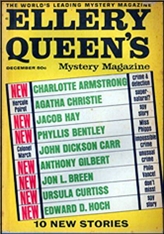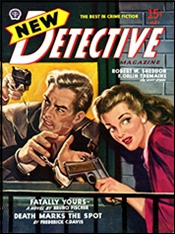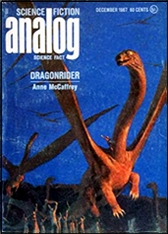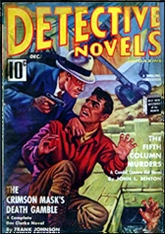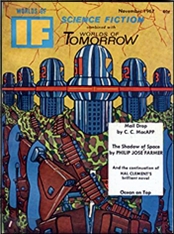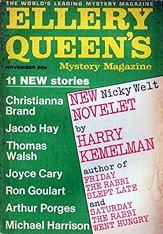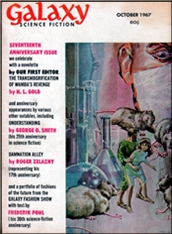(Give Me That) OLD-TIME DETECTION. Summer 2025. Issue #69. Editor: Arthur Vidro. Old-Time Detection Special Interest Group of American Mensa, Ltd. 34 pages (including covers).
THE LATEST ISSUE of OLD-TIME DETECTION focuses on one of detective fiction’s all-time greats, PETER LOVESEY (1936-2025), who passed away in April. OTD editor ARTHUR VIDRO has gathered comments, a 1980 EQMM interview with Lovesey, even a letter that the author wrote to Arthur about OTD, and personal recollections, among them DOUGLAS G. GREENE (“THE LOSS OF PETER LOVESEY, A GREAT WRITER”), JEFFREY MARKS, and MARTIN EDWARDS (“PETER LOVESEY, R.I.P.”).
JON L. BREEN offers a JURY BOX appraisal of print publications that were spawned by Warren Beatty’s 1990 movie interpretation of DICK TRACY, some of which might surprise you, boasting really big names in detective and science fiction.
NEXT UP, TOM MEAD manfully tackles what has been a vexatious topic for years, the “10 MOST PUZZLING IMPOSSIBLE CRIME MYSTERIES.” Long-time detective fiction readers might be familiar with most, if not all, of them, but Mead’s appraisals offer new insights: Carr’s THE THREE COFFINS (a.k.a. THE HOLLOW MAN), Dickson’s THE RED WIDOW MURDERS, Hoch’s “The Long Way Down,” McCloy’s THROUGH A GLASS DARKLY, Dunsany’s “The Two Bottles of Relish,” EQ’s THE CHINESE ORANGE MYSTERY, Rogers’s THE RED RIGHT HAND, Shimada’s THE TOKYO ZODIAC MURDERS, Halter’s THE SEVEN WONDERS OF CRIME, and Crispin’s THE MOVING TOY SHOP. “When done right,” says Mead, “the puzzle and the atmosphere are perfectly intertwined; all the clues are there but they are so ingeniously disguised as to make it nigh-on impossible for the reader to suss out what is going on.”
PERCEPTIVE REVIEWS of a diverse collection of books come next: ARTHUR VIDRO discusses King’s CARELESS CORPSE; LES BLATT talks about Crispin’s THE CASE OF THE GILDED FLY; HARV TUDORRI takes on Berkeley’s THE WYCHFORD POISONING CASE; RUTH ORDIVAR reviews Gardner’s THE CASE OF THE BAITED HOOK; TRUDI HARROV appraises Christie’s POSTERN OF FATE; and RUTH ORDIVAR returns with her take on Guigli’s UNDER THE BLACK FLAG – PIRACY IS NOT A VICTIMLESS CRIME, a 2024 novel which “shares many of the old-time qualities we love.”
THE FICTION SELECTION is excellent, as usual. This time it’s William Brittain’s ingenious “FALLING OBJECT,” which first appeared in EQMM in 1971.
CHARLES SHIBUK continues to chronicle THE PAPERBACK REVOLUTION, that wonderful time when publishers discovered there was gold in them there classic reprints, this time from the mid-seventies: Allingham, Carr, Christie, Ellen, Francis, Hammett, James, Levin, Liebman, Post, Queen, Roueche, Stribling, and Symons.
BACK IN 2016, MARTIN EDWARDS wrote an introduction to MURDER AT THE MANOR: COUNTRY HOUSE MYSTERIES, and it’s reproduced in full here. “Today,” writes Edwards, “enthusiasm for the country house crime story remains as strong as ever.” The same could be said for 2025.
ARTHUR VIDRO continues his series about collecting, “THE VAGARIES OF THE MARKET,” with his and others’ experiences thrown in.
NEXT IS “CHRISTIE CORNER” by DR. JOHN CURRAN, probably the world’s foremost expert on all things Agatha Christie, and, as usual, the ways the good lady’s properties are being handled (and mishandled) come under his close scrutiny. His wise advice for the ages: “LEAVE HER PLOTS ALONE!”
THIS ISSUE of OTD ends with readers’ letters and a baffling puzzle. Overall, the Summer 2025 issue of OLD-TIME DETECTION is worth a look, and maybe even a subscription.
Subscription information:
– Published three times a year: Spring, summer, and autumn. – Sample copy: $6.00 in U.S.; $10.00 anywhere else. – One-year U.S.: $18.00. – One-year overseas: $40.00 (or 30 pounds sterling or 40 euros). – Payment: Checks payable to Arthur Vidro, or cash from any nation, or U.S. postage stamps or PayPal. Mailing address:
Arthur Vidro, editor
Old-Time Detection
2 Ellery Street
Claremont, New Hampshire 03743
Web address: vidro@myfairpoint.net
